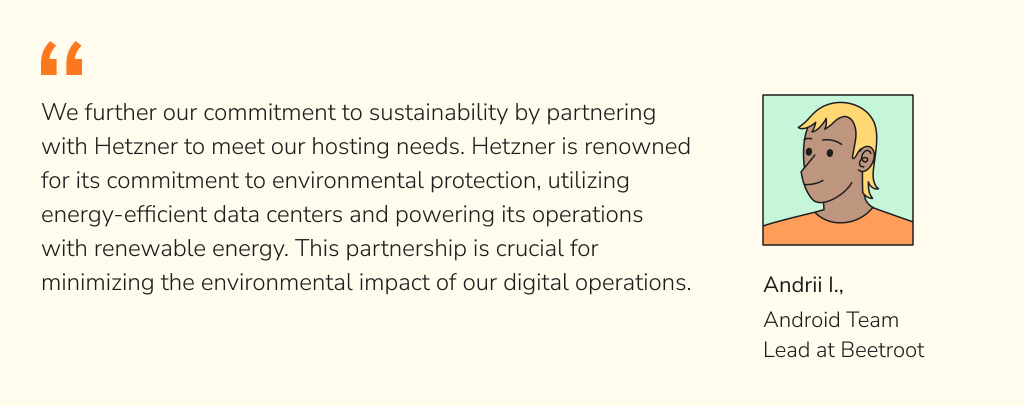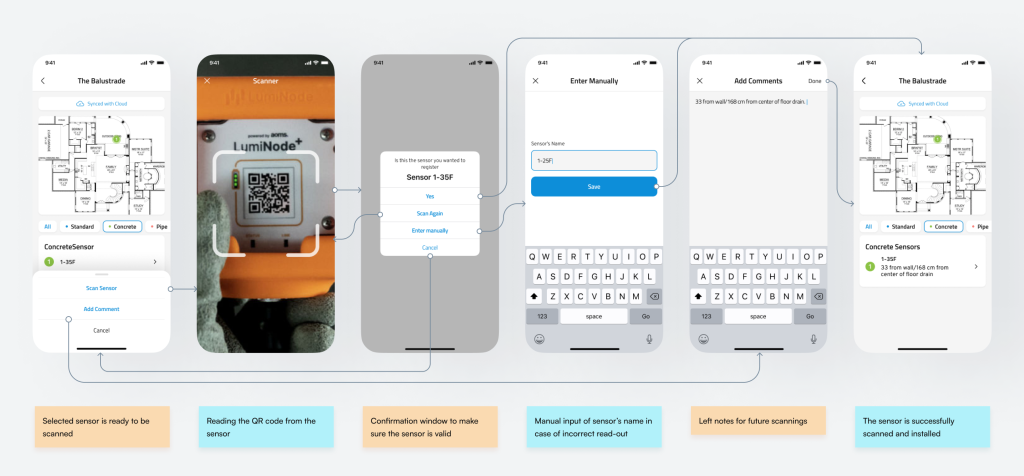
Essential Considerations in CleanTech App Development
Contents
Contents
The increasingly visible impacts of climate change and the urgent need to mitigate environmental harm are some of the reasons why sustainability has taken center stage in global discussions. The demand for green technology solutions is surging, especially in software development. The CleanTech sector is experiencing significant growth, with the market projected to reach $7.4 trillion by 2030, up from $5.5 trillion in 2023.
CleanTech apps cover a broad range of solutions, from carbon footprint calculators and energy management platforms to smart IoT systems and everyday sustainability apps. Developers in this field need to embrace a holistic approach that prioritizes energy efficiency and minimizes environmental impact. In today’s article, we’ll explore the key factors that set eco-friendly apps apart from traditional software development.
Defining CleanTech App Development
CleanTech app development involves creating digital solutions that use less energy, generate a lower carbon footprint, and actively contribute to sustainability through:
- Optimizing resource usage (energy, water, materials)
- Reducing carbon emissions
- Promoting renewable energy adoption
- Enhancing waste management and recycling efforts
- Supporting sustainable agriculture and food systems
- Facilitating environmental monitoring and conservation
The IT industry itself is a massive consumer of energy and natural resources (between 5 and 15% of global electricity consumption). As green software development partners, we aim to help our clients create applications that perform well while incorporating sustainable practices throughout the development lifecycle. This means evaluating the environmental impact of everything—from the servers powering the app to the behaviors it encourages among users.
Key Considerations in the Development of Sustainability Apps
When it comes to CleanTech mobile apps, the path to true sustainability starts behind the scenes. Developing these apps goes beyond technical expertise—it requires carefully balancing innovation with environmental responsibility. Here are some key strategies to consider for this holistic approach:
Sustainable Architecture and Infrastructure
The foundation of any application lies in its architecture and infrastructure. The choices made here—whether in hosting or backend—define your app’s overall footprint. Best practices include:
- Choosing eco-friendly hosting solutions
Hosting your CleanTech app on energy-hungry servers is like running an electric car on coal—it defeats the purpose. Instead, opt for eco-friendly hosting providers like Green Geeks, A2 Hosting, Krystal, Hetzner, or AWS, all of which are committed to using renewable energy for their data centers.
Make sure to look for certifications like LEED (Leadership in Energy and Environmental Design), Energy Star, or Green Web Foundation. These certifications verify that the provider sources renewable energy and takes steps to account for their carbon emissions.

- Implementing serverless architectures
Serverless computing, offered by platforms like AWS Lambda and Azure Functions, allocates resources dynamically, reducing energy waste. For example, a solar monitoring app could trigger AWS Lambda only when new data is received, cutting idle server time. However, serverless costs—both financial and environmental—can increase if event triggers are frequent, so your development team needs to consider the potential trade-offs versus execution frequency.
- Designing for scalability
Using containerization technologies like Docker and Kubernetes allows apps to scale resources efficiently as demand fluctuates. Managed services like AWS EKS and Azure AKS ensure your CleanTech solutions can meet demand without wasting resources.
Energy-Efficient Coding Practices
Every line of code consumes energy, and small improvements can have a large cumulative effect. Sustainable software development practices not only reduce environmental impact but can improve overall app performance. Consider focusing on these strategies:
- Optimizing algorithms: Use efficient data structures (e.g., hash tables, B-trees) and caching solutions (e.g., Redis, Memcached) to reduce computational overhead. Optimizing database queries with indexing and tuning also lowers power consumption.
- Efficient use of device resources: Minimize CPU and memory usage through techniques like worker threads, memory pooling, and batch processing. Efficient API queries (e.g., GraphQL) also help conserve energy.
- Power-saving features: Implement dark mode, offline mode (via Service Workers, IndexedDB), and intelligent background processing (e.g., Background Fetch API). These features reduce energy consumption, especially in apps with heavy data processing or offline access needs.
For example, a carbon footprint tracker could employ Redis to cache frequently accessed data, reducing energy use. Similarly, a smart home energy app could utilize Web Workers for complex calculations, ensuring smooth UI performance while minimizing resource usage.

Data Management and Analytics for Sustainability
Data is the backbone of every CleanTech app, and managing it well is key to tracking and improving sustainability efforts. Here are some important strategies to keep in mind:
- Big data solutions: Tools like Apache Spark and Hadoop process large data volumes for real-time impact analysis, optimizing energy usage in systems like smart city management.
- Data accuracy and reliability: Server-side validation (e.g., Joi, Hibernate Validator) and quality checks (e.g., Great Expectations) ensure data accuracy, while blockchain (e.g., Hyperledger Fabric) secures tamper-proof records, crucial for carbon credit trading.
- Predictive models: Machine learning tools like TensorFlow and scikit-learn create predictive models, such as wind turbine maintenance systems that forecast failures, enhancing efficiency and minimizing downtime.
Integration with Green Technologies and IoT
CleanTech apps often need to connect with a range of hardware and software systems. Ensuring they’re compatible with renewable energy platforms, handle real-time data collection, and maintain interoperability across different green tech tools is essential for building comprehensive sustainable solutions for GreenTech. The table below provides an overview of key protocols and standards applied for creating robust and interoperable sustainability apps.
Technology and Standards for CleanTech Apps
| Category | Technology/Standard | Purpose |
| Compatibility with Renewable Energy Systems | SunSpec Alliance | Information standards for solar and energy storage |
| OpenADR | Automated demand response in electricity grids | |
| MQTT | Lightweight messaging for IoT devices | |
| IEC 61850 | Communication in power utility automation systems | |
| OPC Unified Architecture (OPC UA) | Platform-independent data exchange in industrial automation | |
| Real-Time Data Collection and Analysis | Apache Kafka | Real-time data pipelines and streaming |
| Apache Flink | Stateful computations over data streams | |
| InfluxDB | Time series database for IoT data | |
| Grafana | Interactive visualizations of real-time data | |
| Ensuring Interoperability | OneM2M | M2M and IoT device interoperability |
| W3C Web of Things | Reducing IoT fragmentation | |
| OpenADR | Automated demand response in smart grids | |
| Zigbee | Wireless protocol for IoT devices in smart energy systems | |
| LoRaWAN | Low-power, wide-area networking protocol for IoT and environmental monitoring |
For instance, an API using the SunSpec protocol can communicate with solar inverters to collect real-time production data, allowing users to optimize their energy consumption patterns. Similarly, smart building management systems can employ the OneM2M standard to ensure interoperability between diverse building systems (such as HVAC, lighting, and security) from different manufacturers, enabling centralized control and more efficient energy usage across the entire facility.

Technological Innovations Propelling Mobile Apps for CleanTech
As clean tech continues to evolve, the integration of advanced technologies like AI and machine learning (ML) is driving innovative solutions for sustainability. These technologies enable smarter resource allocation, personalized user experiences, and robust data security, making clean tech apps more efficient and impactful.
AI and Machine Learning
AI and ML are transforming sustainable app development by making processes more efficient, predicting environmental trends, and offering personalized sustainability insights.
- Personalized sustainability recommendations: Leveraging tools like TensorFlow Recommenders or Amazon Personalize, developers can create recommendation systems tailored to users’ energy-saving habits. By analyzing data on user behavior, home characteristics, and weather patterns, apps can suggest personalized actions that reduce energy consumption.
- Predictive maintenance: AI models can also play a crucial role in maintaining renewable energy infrastructure. For instance, they can analyze sensor data from wind turbines to predict potential failures, optimize maintenance schedules, and reduce costly downtimes.
- Natural language processing (NLP): AI-powered chatbots and virtual assistants provide instant, personalized answers to users’ questions, enhancing sustainability education and user engagement.
Security Measures in CleanTech Apps
Security in clean tech apps isn’t just about data protection—it’s about safeguarding critical infrastructure and ensuring user trust. As IoT devices and sensitive environmental data become more common, having solid security in place is more important than ever.
- Blockchain for data integrity: Blockchain can track carbon credits in trading markets, preventing fraud and double-counting while also verifying renewable energy certificates. Platforms like IBM’s Carbon Credit Blockchain and Energy Web Foundation’s EW Ecosystem are setting the standard for transparent, immutable records in clean tech applications.
- IoT security: Secure boot, OTA updates, and network segmentation protect these networks and smart meters from tampering, allowing to isolate critical systems like HVAC from user-facing apps.
- Data encryption and privacy: CleanTech apps often handle sensitive data, from individual energy consumption patterns to proprietary environmental technologies. End-to-end encryption, homomorphic encryption, and differential privacy ensure sensitive data remains secure without sacrificing functionality.
- Secure API management: Many CleanTech apps interact with various data sources through APIs, making API security critical. OAuth 2.0, OpenID Connect, rate-limiting, and throttling protect APIs from unauthorized access and maintain service availability.
Compliance and Continuous Security Monitoring
Clean tech applications must adhere to regulatory standards such as GDPR or CCPA for data protection, especially when dealing with both personal and environmental data. To go a step further, aligning security measures with frameworks like the Global Reporting Initiative (GRI) ensures compliance and the integrity of sustainability efforts.
Continuous security monitoring through Security Information and Event Management (SIEM) helps detect and respond to potential threats in real-time, while regular audits and tailored incident response plans safeguard critical data and maintain operations. By implementing these measures, CleanTech apps can protect sensitive data, uphold sustainability goals, and build trust, with robust security remaining a key priority.
Challenges and Ethical Considerations in CleanTech Mobile App Development Services
Developing sustainable apps comes with its own set of challenges and ethical considerations. Addressing them is crucial for maintaining their effectiveness and credibility.
Data Privacy
To comply with regulations like GDPR, CCPA, PIPEDA, and others, developers need to obtain explicit consent, limit data collection to what’s necessary, and use strong encryption to protect data both in transit and at rest. These practices help build and maintain user trust when handling sensitive data such as energy usage patterns or environmental behaviors.
AI Bias and Fairness
While AI can improve CleanTech apps by offering personalized sustainability tips and optimizing resource usage, it can also introduce bias if not managed carefully. AI bias refers to systematic errors or unfair outcomes in artificial intelligence systems that can lead to discriminatory or prejudiced results. Regular audits, fairness-focused techniques like adversarial debiasing, and explainable AI models are crucial to ensuring that AI systems remain transparent, equitable, and accessible to all users.
Accessibility and Performance Optimization
CleanTech apps should be accessible to users of all backgrounds, including those with disabilities or limited access to technology. Prioritizing inclusivity also means implementing features like screen reader compatibility, adjustable text sizes, and alternative input methods. Additionally, color schemes should be designed with consideration for users with color vision deficiencies. Make sure to check out our handy guide on digital accessibility for practical tips and directions.
Apps should also function well in low-connectivity areas——like those in agriculture and green energy—by using offline features and data-efficient Progressive Web Apps (PWAs). Lightweight designs, efficient coding, and techniques like lazy loading and code splitting help ensure good performance on all devices. This approach reduces strain on systems while keeping key features intact, making CleanTech solutions more accessible to a wider audience.
Greenwashing Prevention
As public awareness of environmental issues grows, consumers and regulators expect impact-oriented companies to truly ‘walk the walk’, supporting their ecological claims with real action. Misleading claims about sustainability can swiftly backfire, eroding trust and damaging reputations. As developers, we have a responsibility to ensure our applications provide genuine environmental benefits and don’t contribute to greenwashing. This involves transparent reporting of environmental impact and adhering to established sustainability standards like the GRI, ISO 14064, or B Corp. Being authentic in your green efforts ensures that your company is seen as a genuine force for good.
Regulatory Compliance
As regulations around environmental sustainability continue to evolve, clean tech apps must stay compliant to maintain their legal and ethical standing. This involves adhering to frameworks like GRI for sustainability reporting and following new rules, such as the Corporate Sustainability Reporting Directive (CSRD) for businesses in Europe. Features that allow companies to easily generate reports aligned with these standards to comply with regulations and showcase real commitment to their environmental goals.
Transparent Carbon Footprint Calculations
Accurate carbon footprint tracking is another critical area where CleanTech apps can add value. By following established guidelines like the Greenhouse Gas Protocol and ISO 14064, developers can ensure that the carbon calculations within their apps are reliable and meaningful, enhancing the credibility of the organizations that use them.
Ethical AI and Data Usage
Beyond regulatory requirements, there is a growing expectation that CleanTech companies use AI and data ethically. Implementing AI governance frameworks ensures responsible AI development, while regular audits help keep systems fair and transparent. By embracing these principles, CleanTech apps can build trust and demonstrate a true commitment to ethical innovation.
At Beetroot, we see AI as a powerful tool to drive progress toward the UN’s Sustainable Development Goals and support environmental conservation, especially within GreenTech, while also being mindful of its ecological footprint. Our approach is twofold: leveraging AI for impactful innovation and ensuring its development aligns with our values of sustainability and social responsibility.

Future Trends in CleanTech App Development
While we’ve explored AI and Machine Learning in the technological innovations section, it’s worth noting that these technologies are only a part of a much broader spectrum of advancements shaping the future of sustainable applications.
Advanced Computing for Environmental Modeling
The future of CleanTech apps lies in their ability to process and analyze increasingly complex environmental data. Edge computing reduces energy consumption and latency by bringing computation closer to data sources, while quantum computing holds the potential to optimize resource allocation on a larger scale.
These advanced computing methods are not just theoretical concepts but are already being applied in various CleanTech scenarios. For a deeper dive into how these technologies are being leveraged in sustainability efforts, including specific use cases and potential future applications, we recommend reading our recent article on AI in GreenTech and sustainability.
AR and VR for Sustainability Education
As we strive to make environmental issues more tangible and relatable, immersive technologies step in as powerful tools for sustainability education, promising to offer experiences that enhance environmental awareness in ways traditional methods won’t allow.
Imagine a CleanTech app that uses AR to show users the real-time carbon footprint of products as they shop or a VR experience that transports users to a future affected by climate change. These engaging, experiential approaches to environmental education could drive home the importance of sustainability in a visceral way.
5G and Beyond for Enhanced IoT Capabilities
The rollout of 5G and future network technologies will enable more sophisticated, real-time IoT applications in CleanTech. By 2025, 5G is likely to cover one-third of the global population. Higher bandwidth and lower latency can support a vastly expanded network of environmental sensors, enabling more comprehensive and timely data collection.
So, enhanced connectivity could power applications ranging from more efficient smart grids to real-time environmental monitoring systems capable of detecting and responding to pollution events almost instantly.
Integrating Multiple Technologies for Holistic Solutions
Perhaps the most exciting trend is the potential for integrating these various technologies to create holistic clean tech solutions. For instance, an application might use IoT sensors to collect environmental data, process it using edge computing for real-time insights, leverage quantum computing for complex long-term predictions, and present the results through an AR interface.
This integration of multiple advanced technologies exemplifies the direction in which CleanTech app development is heading—towards more comprehensive, powerful, and user-friendly solutions to our most pressing environmental challenges.
Building a Sustainable App Development Team for Lasting Impact
As a tech company, we know our actions play a big role in shaping how technology impacts the world. Sustainability doesn’t happen in isolation—it’s a team effort that brings together developers, environmental experts, and domain specialists. Equally important is incorporating diverse perspectives, which drive innovation and foster inclusive solutions to the complex challenges in CleanTech.
Ethical leadership instills environmental responsibility across the team, ensuring sustainability is a core value in every decision. With tougher regulations like the Corporate Sustainability Reporting Directive (CSRD), working with partners who are equally committed to sustainability makes compliance smoother and amplifies positive outcomes, ensuring that your apps don’t just comply with the rules but also pave the way for meaningful innovation and growth.
In the fast-moving world of CleanTech, staying ahead requires continuous learning. Your team needs to be up to date on the latest green design trends and sustainable development practices. Through our Academy, we offer specialized training programs and workshops in AI, green coding, cybersecurity, and more, equipping your team with the skills needed to innovate sustainably and stay competitive.
By building teams with these principles in mind, we deliver measurable results—like reducing carbon emissions and improving resource efficiency. Together, we’re shaping a future where technology and sustainability work hand in hand. If this resonates with your vision, let’s turn it into reality.
Subscribe to blog updates
Get the best new articles in your inbox. Get the lastest content first.
Recent articles from our magazine
Contact Us
Find out how we can help extend your tech team for sustainable growth.






